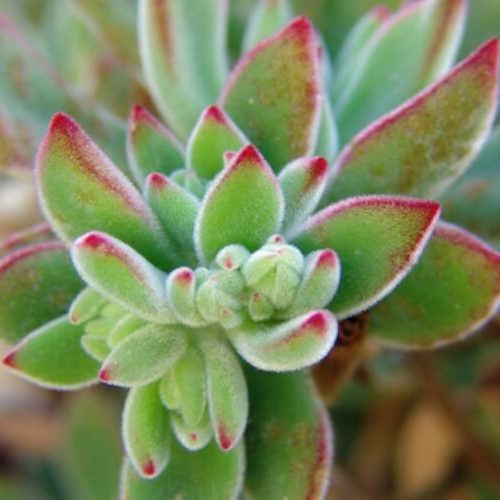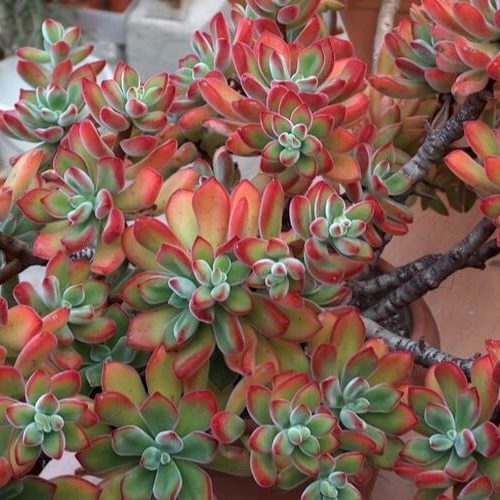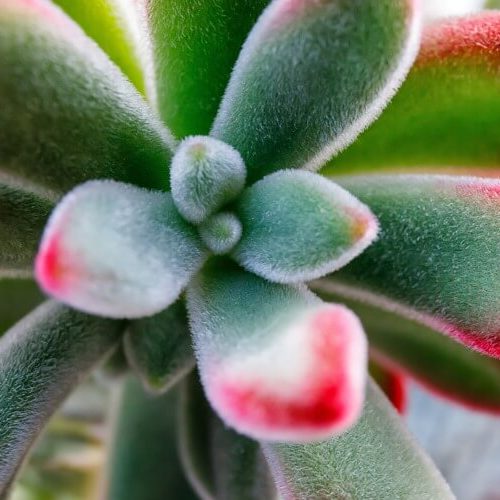
Echeveria Pulvinata ‘Ruby’ Care
Echeveria Pulvinata 'Ruby' is a captivating succulent known for its plush foliage and vibrant hues. This post will explore the unique characteristics of this succulent, from its origin to its care requirements, offering enthusiasts an insightful guide into nurturing this ruby-tinted gem.
Zones: 9b - 11b
Sun, Shade
Average, Well-Drained, Gritty
Fall, Winter
Drought Tolerant, Regular
Indoors, Outdoors
Seed, Cuttings
Considered non-toxic
ALso Known AS
Plush Plant, Chenille Plant, Ruby Slippers, Ruby Blush, Red Velvet
Origin
Rocky terrains of Mexico
leaf shape
Plush and velvety, with a slightly rounded, ovate shape. The edges of the leaves are often tinged with a ruby-red color
difficulty
Great for Beginners
Echeveria Pulvinata ‘Ruby’ is a specially cultivated variant of the Echeveria Pulvinata, a species native to the mountainous regions of Oaxaca, Mexico. Characterized by its distinctive rosette formation, this succulent features leaves densely covered in microscopic white hairs, imparting a unique velvety texture. The rosettes typically reach a size of 3 to 4 inches in width, forming a compact yet lush display.
The plant’s appearance is reminiscent of soft velvet or a delicate layer of morning frost, earning it the nicknames “plush plant” or “chenille plant”. Its leaves are a rich, velvety green, accentuated by striking red tips that become more pronounced under environmental stress or cooler temperatures. Adding to its beauty, Echeveria Pulvinata ‘Ruby’ produces bell-shaped orange flowers, which typically bloom during the cooler months, contrasting elegantly against the soft, plush foliage.
The interplay of colors and textures on this succulent is dynamic, with the intensity of the red tips varying based on factors like sunlight exposure and temperature changes, making it a fascinating and visually dynamic addition to any succulent collection.
Water Needs
Check the soil for dryness before watering. Plush plants are very susceptible to root rot, so water rarely, but deeply.
TEMPERATURE / Hardiness
Zones: 9b - 11b
Temperatures just above freezing and direct sun will make this succulent produce a brighter red color in the leaves.
Light
Prefers lots of light if indoors, can tolerate partial shade. Outdoors they prefer indirect sunlight and away from extreme heat. Growth will show faster with more sunlight.
dormancy
Echeveria Pulvinata 'Ruby' enters a dormancy period during the colder months. During this time, it requires minimal watering and should be kept in a cool, dry place with plenty of indirect light to maintain its health and prepare for spring growth.
Size
This succulent typically grows to about 6 to 8 inches in diameter, with the rosettes forming a compact, dense cluster.
Toxicity
This succulent is generally considered non-toxic to pets. However, it's always a good practice to keep plants out of reach of pets to avoid any potential issues.
flowers
FallWinterProduces bell-shaped orange flowers, which typically bloom during the cooler months.
Soil
This Echeveria prefers a well-draining soil mix, ideally formulated for succulents or cacti.
Feeding
It benefits from fertilization during the growing season with a diluted, balanced, low-nitrogen succulent fertilizer. Avoid fertilizing in winter during its dormant period.



how do you propagate Echeveria Pulvinata Ruby?
propagated from:
SeedCuttingsPropagates easily from leaf cuttings or stem cuttings. Remove a leaf from the mother plant with a clean straight cut, leave to callous for a few days, then place in the soil until roots appear.
FAQ
Frequently asked questions about Echeveria Pulvinata Ruby

What is the best way to water Echeveria Pulvinata 'Ruby'?
Echeveria Pulvinata 'Ruby' should be watered thoroughly when the soil is completely dry, and then let it dry out again before the next watering. I prefer to use the bottom watering method to ensure the soil is completely saturated. Overwatering can lead to root rot, so it's important to ensure good drainage.

How much sunlight does Echeveria Pulvinata 'Ruby' need?
This succulent prefers bright, indirect sunlight. Direct sunlight, especially in the harsh midday, can burn the leaves, while insufficient light can cause the plant to stretch and lose its compact rosette shape. A spot with morning sun and afternoon shade is ideal.
Similar Topics in: Crassulaceae, Echeveria, Sedoideae